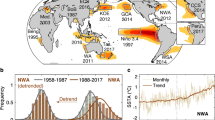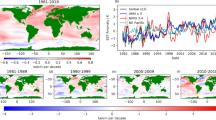Abstract
Marine heatwaves have been shown to be increasing in frequency, duration and intensity over the past several decades. Are these changes related to rising mean temperatures, changes to temperature variability, or a combination of the two? Here we investigate this question using satellite observations of sea surface temperature (SST) covering 36 years (1982–2017). A statistical climate model is used to simulate SST time series, including realistic variability based on an autoregressive model fit to observations, with specified trends in mean and variance. These simulated SST time series are then used to test whether observed trends in marine heatwave properties can be explained by changes in either mean or variability in SST, or both. We find changes in mean SST to be the dominant driver of the increasing frequency of marine heatwave days over approximately 2/3 of the ocean; while it is the dominant driver of changes in marine heatwave intensity (temperature anomaly) over approximately 1/3 of the ocean. We also find that changes in mean SST explain changes in both MHW properties over a significantly larger proportion of the world’s ocean than changes in SST variance. The implication is that given the high confidence of continued mean warming throughout the twenty-first century due to anthropogenic climate change we can expect the historical trends in marine heatwave properties to continue over the coming decades.
Similar content being viewed by others
References
Banzon V, Smith TM, Chin TM, Liu C, Hankins W (2016) A long-term record of blended satellite and in situ sea-surface temperature for climate monitoring, modeling and environmental studies. Earth Syst Sci Data 8(1):165
Benthuysen JA, Oliver EC, Feng M, Marshall AG (2018) Extreme marine warming across tropical australia during austral summer 2015–2016. J Geophys Res Oceans 123:1301–1326
Bond NA, Cronin MF, Freeland H, Mantua N (2015) Causes and impacts of the 2014 warm anomaly in the NE Pacific. Geophys Res Lett 42(9):3414–3420
Deser C, Alexander MA, Xie SP, Phillips AS (2010) Sea surface temperature variability: patterns and mechanisms. Annu Rev Mar Sci 2:115–143
Di Lorenzo E, Mantua N (2016) Multi-year persistence of the 2014/15 North Pacific marine heatwave. Nat Clim Change 6(11):1042–1047
Drijfhout S, Van Oldenborgh GJ, Cimatoribus A (2012) Is a decline of AMOC causing the warming hole above the North Atlantic in observed and modeled warming patterns? J Clim 25(24):8373–8379
Field CB, Barros V, Stocker TF, Qin D, Dokken DJ, Ebi KL, Mastrandrea MD, Mach KJ, Plattner GK, Allen SK (2012) Managing the risks of extreme events and disasters to advance climate change adaptation. Cambridge University Press, Cambridge
Frankignoul C, Hasselmann K (1977) Stochastic climate models, Part II application to sea-surface temperature anomalies and thermocline variability. Tellus 29(4):289–305
Frölicher TL, Laufkötter C (2018) Emerging risks from marine heat waves. Nat Commun 9(1):650
Hasselmann K (1976) Stochastic climate models part I. Theory Tellus 28(6):473–485
Hobday AJ, Alexander LV, Perkins SE, Smale DA, Straub SC, Oliver EC, Benthuysen JA, Burrows MT, Donat MG, Feng M (2016) A hierarchical approach to defining marine heatwaves. Prog Oceanogr 141:227–238
Hughes TP, Kerry JT, Álvarez-Noriega M, Álvarez-Romero JG, Anderson KD, Baird AH, Babcock RC, Beger M, Bellwood DR, Berkelmans R (2017) Global warming and recurrent mass bleaching of corals. Nature 543(7645):373
Oliver ECJ, Wotherspoon SJ, Holbrook NJ (2014) Projected Tasman Sea extremes in sea surface temperature through the 21st Century. J Clim 27(5):1980–1998
Oliver ECJ, Donat MD, Burrows MT, Moore PJ, Smale DA, Alexander LV, Benthuysen JA, Feng M, Sen Gupta A, Hobday A, Holbrook NJ, Perkins-Kirkpatrick SE, Scannell HA, Straub SC, Wernberg T (2018) Longer and more frequency marine heatwaves over the past century. Nat Commun 9:1324
Priestley MB (1981) Spectral analysis and time series. Academic Press, New York
Reynolds RW, Smith TM, Liu C, Chelton DB, Casey KS, Schlax MG (2007) Daily high-resolution-blended analyses for sea surface temperature. J Clim 20(22):5473–5496
Smale D, Wernberg T, Oliver ECJ, Thomsen M, Harvey B, Straub S, Burrows M, Alexander L, Benthuysen J, Donat M, Feng M, Hobday A, Holbrook N, Perkins-Kirkpatrick S, Scannell H, Sen Gupta A, Payne B, Moore P (2019) Marine heatwaves threaten global biodiversity and the provision of ecosystem services. Nat Clim Change. https://doi.org/10.1038/s41558-019-0412-1
Stammer D (1997) Global characteristics of ocean variability estimated from regional TOPEX/POSEIDON altimeter measurements. J Phys Oceanogr 27(8):1743–1769
Stocker T, Dahe Q, Plattner GKE (2013) Working group I contribution to the IPCC fifth assessment report climate change 2013, the physical science basis. IPCC
Wernberg T, Smale DA, Tuya F, Thomsen MS, Langlois TJ, De Bettignies T, Bennett S, Rousseaux CS (2013) An extreme climatic event alters marine ecosystem structure in a global biodiversity hotspot. Nat Clim Change 3(1):78
Woodworth PL, Menendez M (2015) Changes in the mesoscale variability and in extreme sea levels over two decades as observed by satellite altimetry. J Geophys Res Oceans 120(1):64–77
Wu L, Cai W, Zhang L, Nakamura H, Timmermann A, Joyce T, McPhaden MJ, Alexander M, Qiu B, Visbeck M (2012) Enhanced warming over the global subtropical western boundary currents. Nat Clim Change 2(3):161–166
Acknowledgements
This study makes a contribution to the International Marine Heatwaves Working Group (http://www.marineheatwaves.org). NOAA High Resolution SST data provided by the NOAA/OAR/ESRL PSD, Boulder, Colorado, USA, from their Web site at https://www.esrl.noaa.gov/psd/. This work was supported by the National Sciences and Engineering Council of Canada (NSERC) Discovery Grant RGPIN-2018-05255.
Author information
Authors and Affiliations
Corresponding author
Additional information
Publisher's Note
Springer Nature remains neutral with regard to jurisdictional claims in published maps and institutional affiliations.
Appendix
Appendix
Start with a stationary time series T(t), where t is time, with mean \(\mu =0\) and variance \(\sigma ^2\). The mean and variance do not change with time. We wish to generate two new time series: \(T_m(t)\) which has a linearly increasing mean value (but constant variance \(\sigma ^2\)) and \(T_v(t)\) which has linearly increasing variance (but constant mean \(\mu\)).
1.1 Increasing mean
Let us define \(T_m = T + mt\), where m is a constant. This time series has a mean and variance given by
where \(E(\cdot )\) is the expectation operator and noting that \(E(T)=\mu =0\). Therefore \(T_m\) has a linearly increasing mean and the same (constant) variance as T, \(\sigma ^2\).
1.2 Increasing variance
Let us define \(T_v = T(1 + vt)\), where v is a constant. This time series has a mean and variance given by
and noting that \(E(T^2)=\sigma ^2\). If we neglect nonlinearities, we can simplify this to a linear dependence on time
where \(v^* = 2 v \sigma ^2\).
Rights and permissions
About this article
Cite this article
Oliver, E.C.J. Mean warming not variability drives marine heatwave trends. Clim Dyn 53, 1653–1659 (2019). https://doi.org/10.1007/s00382-019-04707-2
Received:
Accepted:
Published:
Issue Date:
DOI: https://doi.org/10.1007/s00382-019-04707-2










